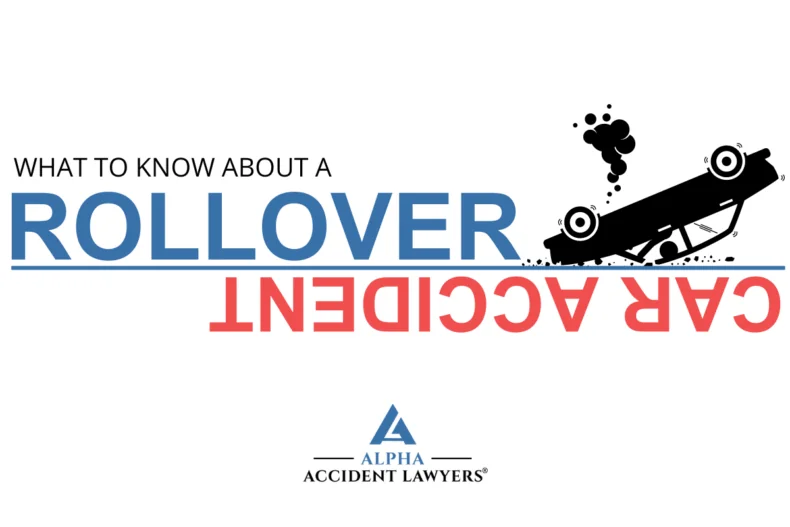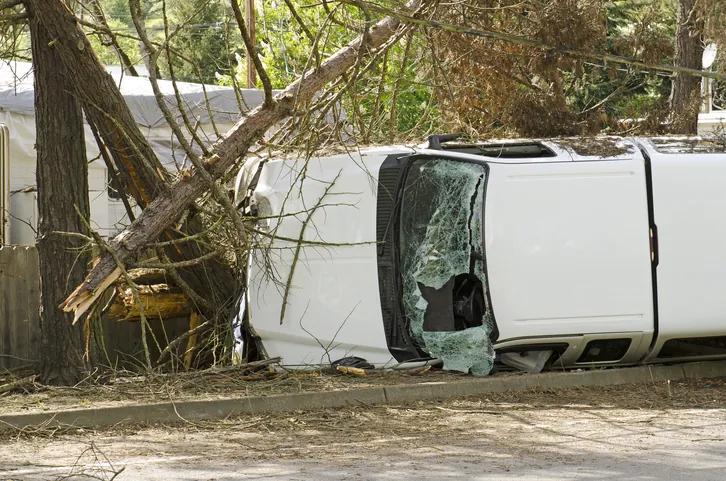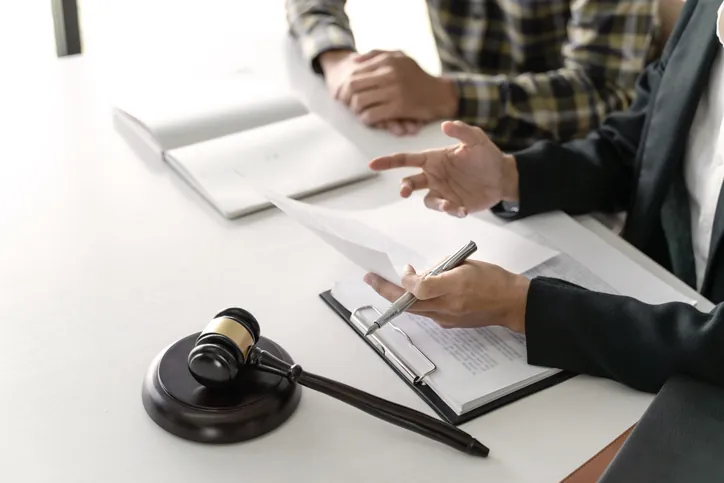What Is a Rollover Car Accident?
A rollover car accident occurs when a vehicle flips over onto its side or roof during a collision. Rollover crashes are one of the most dangerous types of car accidents. Single-vehicle crashes are more common in rollovers, although they can also occur in multi-vehicle collisions. Most rollovers occur in passenger vehicles with a high center of gravity, like a pickup truck or an SUV. However, any car can roll over and result in devastating injuries or fatalities.
If you sustained serious injuries in a rollover crash caused by someone else’s negligence, you may be able to pursue fair compensation for your injuries and losses. An experienced car accident attorney can help you prove liability and hold the at-fault party liable.
What Can Cause Rollover Accidents?
High-Speed Turns
Taking turns at excessive speeds can lead to loss of control, especially if the turn is sharp. The centrifugal force generated during high-speed maneuvers can cause the vehicle to tip over, resulting in a rollover.
Tripping Hazards
Tripping occurs when a vehicle’s tires make contact with an object or surface that disrupts its stability. Common tripping hazards include curbs, guardrails, medians, and soft soil on the roadside. Once a vehicle trips, it’s more likely to roll over due to the sudden change in momentum.
Higher Center of Gravity
Vehicles with a higher center of gravity, such as SUVs, trucks, and vans, are more prone to rollovers. Additionally, vehicles with a narrow wheelbase or poor suspension systems may be less stable, increasing the likelihood of rollover truck accidents.
Driver Error
The National Highway Traffic Safety Administration estimates that 94% of all auto accidents are the result of driver error. According to the Federal Motor Carrier Safety Administration (FMCSA), over 78% of cargo tank rollovers involve driver error. Drivers must always be alert and aware of their surroundings and avoid distractions behind the wheel.
Aggressive driving, such as abrupt steering maneuvers or overcorrection, can contribute to rollover accidents. Distracted driving, such as texting or eating while driving, can also impair a driver’s ability to maintain control of the vehicle.
Drunk Driving
Drunk driving is a leading cause of traffic accidents across the United States. About 31% of all traffic fatalities involve drunk drivers. Each day, about 37 people in the US are killed in drunk-driving crashes. Fatal rollover crashes often involve a person driving under the effects of alcohol.
Poor Road Conditions
Uneven road surfaces, potholes, debris, and slippery conditions can all compromise a vehicle’s stability and increase the risk of rollover accidents. Drivers should exercise extra caution when navigating challenging road conditions to avoid potential rollovers.
Why Are Rollover Accidents So Dangerous?
Although rollover crashes (ROCs) account for less than 3% of all passenger vehicle crashes, they make up about 30% of all highway vehicle occupant fatalities. Rollover accidents are particularly dangerous due to several factors:
- High potential for injury: The violent motion of a rollover can cause occupants to be tossed around inside the vehicle, increasing the likelihood of severe injuries. Unlike other types of crashes, rollovers involve multiple impacts as the vehicle rolls, further intensifying the forces exerted on occupants.
- Ejection risk: Rollover accidents often result in partial or complete ejection of occupants from the vehicle. Unrestrained occupants are particularly vulnerable to ejection, which greatly increases the risk of serious injury or fatality. Even properly restrained occupants may be partially ejected if the vehicle’s structure is compromised during the rollover.
- Roof crush risk: As a vehicle rolls over, its roof may collapse due to the force of impact, resulting in crush injuries for occupants trapped inside. Roof crush can lead to severe head and spinal injuries, especially if occupants are not properly restrained or if the vehicle lacks sufficient structural integrity.
- Secondary collisions: Rollover accidents may involve secondary collisions with other vehicles, objects, or the road surface. These secondary impacts can further exacerbate the damage and injuries sustained by occupants, increasing the overall severity of the accident.
Common Injuries Sustained in Rollover Accidents
Rollover accidents can result in a range of injuries, ranging from minor to life-threatening. Here are some common injuries sustained by victims of rollover accidents:
- Broken bones: The violent forces exerted during a rollover can cause bones to fracture or shatter. Fractures are particularly common in areas of the body subjected to direct impact or crushing forces, such as the arms, legs, ribs, and pelvis.
- Lacerations: Vehicle occupants may suffer cuts and lacerations from broken glass, sharp objects inside the vehicle, or contact with the road surface during a rollover. Deep lacerations may require sutures or surgical intervention.
- Skull fractures: Head trauma is a significant risk in rollover accidents, with occupants at risk of striking their heads against the vehicle’s interior or suffering impact from objects within the vehicle. Skull fractures can range from minor hairline fractures to more severe fractures.
- Spinal cord injuries: The sudden jolts and impacts experienced during a rollover can damage the spinal cord, leading to paralysis or other neurological deficits. Spinal cord injuries sustained in rollover accidents can have long-lasting consequences that may affect mobility, sensation, and cognitive function.
- Traumatic brain injuries (TBIs): Head injuries are common in rollover accidents. Vehicle occupants may suffer from traumatic brain injuries ranging from concussions to severe diffuse axonal injuries. TBIs can result in cognitive impairments, physical disabilities, and changes in behavior or personality.
- Internal organ injuries: The force of impact during a rollover can cause internal organs to be bruised, lacerated, or punctured by broken bones or sharp objects. Internal organ injuries may not be immediately apparent but can lead to life-threatening complications if left untreated.
- Amputation: In severe rollover accidents involving crushing or entrapment, occupants may suffer traumatic amputations of limbs.
Factors That Impact the Severity of Rollover Crashes
Several factors influence the severity of rollover crashes, including:
Vehicle type: SUVs, trucks, and vans have a higher risk of rollover due to their higher center of gravity.
Speed: Higher speeds increase the likelihood and severity of a rollover accident.
Road conditions: Poor road conditions such as wet or icy surfaces can exacerbate the risk of rollover.
Driver behavior: Factors such as distracted driving, fatigue, or impairment can contribute to the likelihood and severity of a rollover crash.
Seat belts and airbags: Safety features like seat belts and airbags can help mitigate the severity of injuries in a rollover accident. The risk of ejection from a vehicle in a rollover accident is highest for unrestrained occupants.
Always Wear a Seat Belt
Seat belts are the single most effective safety device for preventing ejection and reducing the risk of injury or death in a rollover accident. According to the National Highway Traffic Safety Administration (NHTSA), if you wear your seatbelt in the front seat of a passenger vehicle, you can reduce your risk of fatal injury by 45%. Moderate to critical injury is reduced by 50% when you buckle up.
When fastening a seat belt, ensure that the lap belt is positioned low across the hips and pelvis and that the shoulder belt crosses the chest and collarbone. Seat belts should be snug but not overly tight, with the lap belt lying flat and the shoulder belt resting securely against the body.
Steps to Take After a Rollover Accident
If you’ve been involved in a rollover accident, it’s essential to take the following steps:
- Check for injuries: Assess yourself and your passengers for injuries and call for emergency services. If you have been injured, it’s best not to move. Further movement can cause more damage to your body.
- Contact emergency services: Call 911 and report the accident. Provide accurate information about the location, number of vehicles involved, and any injuries sustained.
- Seek medical attention: Even if you do not believe you were seriously injured, it is important to seek medical attention promptly after a rollover accident. Some injuries may not be immediately apparent, and delaying treatment could worsen your condition. Ensure you get a medical exam and follow the doctor’s prescribed treatment plan.
- Exchange information: If you can, exchange contact and insurance information with other involved parties At the scene. Gather their names, addresses, phone numbers, license plate numbers, and insurance policy details. Additionally, obtain contact information from witnesses who observed the accident.
- Document the scene: Take photos or videos of the accident scene, including vehicle damage, road conditions, skid marks, and any relevant signage or landmarks. Document the weather and lighting conditions at the time of the accident and any visible injuries.
- Contact an experienced car accident attorney: If you or your passengers have sustained injuries in the rollover accident, consider seeking legal representation from an experienced car accident attorney. A personal injury lawyer will protect your rights, advocate on your behalf, and help you pursue fair compensation for your losses.
Contact an Experienced Rollover Accident Attorney
If you’ve been involved in a rollover accident caused by someone else’s negligence, it’s crucial to consult with an experienced car accident attorney. At Alpha Accident Lawyers, we are dedicated to helping personal injury victims and their families obtain justice. Our car accident attorneys maintain a 99% success rate and have recovered millions of dollars in settlements and verdicts for our clients.
We will guide you through the entire claims process and fight for maximum compensation. Call our award-winning personal injury law firm today to schedule a free consultation.
Call for Your Free Consultation






